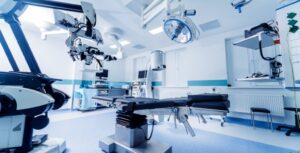The medical brace manufacturing process at Roberson Machine Company is a detailed series of steps that is regulated closely in order to ensure the production of safe, effective, and high-quality devices. Each phase plays a crucial role in creating medical braces that provide proper support and aid recovery for patients.
Call the medical brace manufacturing experts at Roberson Machine Company right away at 573-646-3996 or contact us online for a quick quote. Our expert team has been manufacturing medical brace parts for more than 20 years, utilizing top-tier manufacturing solutions.
Here, we’ll explore the six key phases of medical brace manufacturing and how they contribute to delivering reliable parts to the medical industry.
The Six Phases of Medical Brace Manufacturing at Roberson Machine Company
1. Design and Development
The first phase of medical brace manufacturing is the design and development process. While your team designs, our team makes sure the parts meet the exact specifications and the needs of the patient. This includes:
- Functional Requirements: The parts, and the brace itself, must be functional, comfortable, and tailored to the anatomical needs of the wearer, ensuring proper support and flexibility.
- Understanding Patient Needs: No matter if the brace is intended for injury recovery, post-surgical support, or chronic conditions like arthritis or scoliosis, the parts must cater to the specific medical needs of the patient.
- Prototyping: We create multiple prototypes, testing and refining along the way, to optimize the parts for functionality, durability, and patient comfort.
This phase also involves considering how the brace will be manufactured, including choosing the right methods, materials, and technologies to meet cost, safety, and quality requirements. Our medical brace manufacturing experts are available to help. Give us a call at 573-646-3996 or contact us online to get a quote.
2. Material Selection
The choice of materials is critical to the overall performance of a medical brace. Depending on the type of brace, we work with you to select materials that offer the necessary strength, flexibility, and biocompatibility. Materials we commonly use for customers include:
- Metals: Medical-grade metals like stainless steel, titanium, or aluminum can be used in rigid braces that require durability and strength for bone stabilization.
- Plastics: Lightweight, flexible, and moldable plastics are frequently used for parts used in braces designed for soft tissue injuries or to support minor fractures.
- Composites: Some advanced braces incorporate composite materials that combine lightweight features with strength, providing the best of both worlds.
Material selection is also influenced by other factors, including sterilizability and patient comfort. The right material ensures that the medical brace can perform effectively while minimizing risks like skin irritation or infection.
3. Prototyping and Testing
Prototypes are usually built using our 3D printing or CNC machining capabilities to create precise models that can be tested for performance. This includes:
- Compliance: The prototype must meet all medical device guidelines, including those set by the FDA and any other regulatory bodies.
- Durability: Stress tests are conducted to evaluate the brace’s ability to withstand regular use without losing effectiveness.
- Fit & Functionality: The medical brace is tested on patients or models to make sure it fits comfortably and provides the necessary support.
Testing is a crucial part of the process because it helps identify any potential problems with the design, functionality, or materials before the parts go into full production.
4. Manufacturing
Once you approve the prototype and all the necessary assessments are complete, the manufacturing phase begins. This involves using our unparalleled manufacturing solutions and value-added services, including:
The goal of this phase is to make sure that every part of every brace manufactured meets the same high standards as the prototype, maintaining consistency across every unit.
5. Packaging and Distribution
This stage at Roberson Machine Company involves:
- Sterilization: Depending on the type of part, sterilization may be necessary to prevent contamination before use on a brace.
- Secure Packaging: We carefully package our manufactured parts to be sure they’re uncontaminated and best ready for the next step during transportation and storage.
This phase is critical to ensuring that the brace parts are delivered in pristine condition, ready for use in patients’ braces.
6. Post-Production Monitoring and Feedback
Even after a medical brace or part has been manufactured and distributed, the process doesn’t end. The team at Roberson Machine Company engages in post-production monitoring and gathers feedback to make sure the parts and braces are performing as intended. This phase helps identify any possible issues with the product, or even the shipping/delivery process, and contributes to future improvements in design, materials, or our manufacturing solutions.

Reach Out to the Roberson Machine Company Experts to Learn the Phases of Medical Brace Manufacturing
Medical brace manufacturing is a complex process that involves multiple phases, from design and material selection to packaging and post-production. By carefully following each phase, our team ensures that every one of your medical brace parts are safe, effective, and reliable. At Roberson Machine Company, we specialize in manufacturing high-quality medical braces and parts, leveraging our advanced machining capabilities to deliver components that meet the highest industry standards.
If you’re looking for the best in medical brace manufacturing solutions, call us as soon as possible at 573-646-3996 or contact us online to request a quote.





